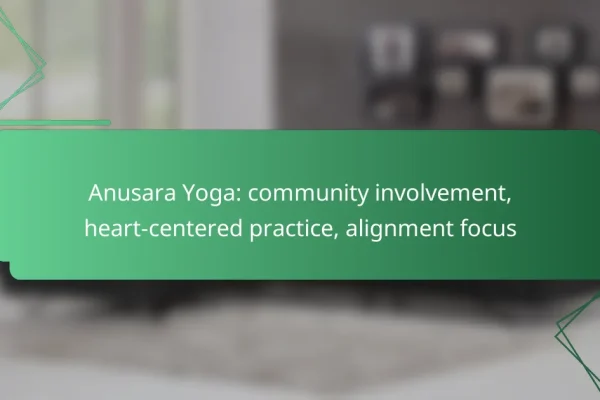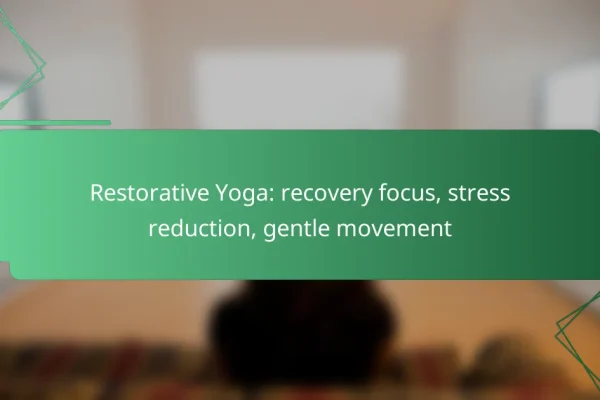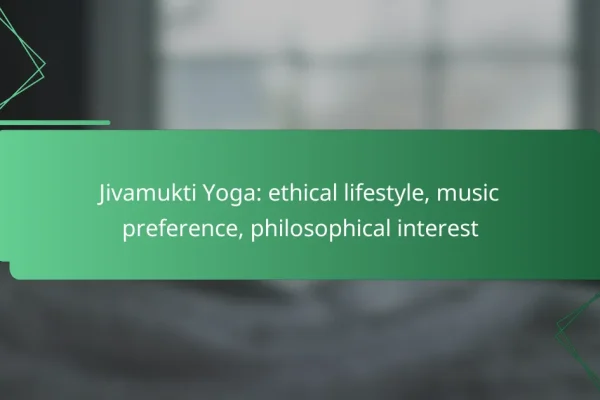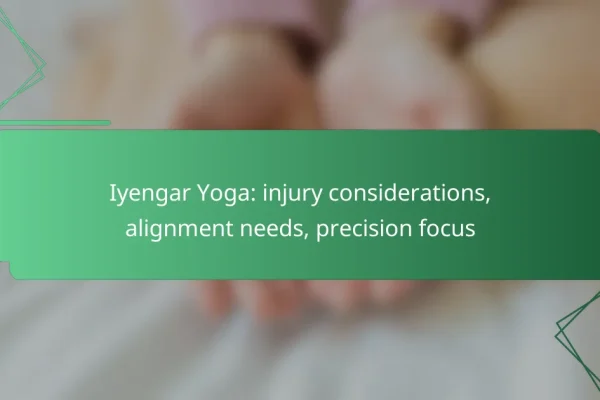What are the best yoga styles for beginners in the US?
The best yoga styles for beginners in the US include Hatha, Vinyasa, Yin, and Restorative yoga. Each style offers unique benefits and approaches, making them suitable for those new to yoga.
Hatha Yoga
Hatha yoga is often recommended for beginners due to its slower pace and focus on basic postures. Classes typically include a combination of physical poses, breathing exercises, and meditation, allowing newcomers to build a solid foundation.
When attending a Hatha class, expect to hold poses for longer periods, which helps improve flexibility and strength. Look for classes labeled as “beginner” or “gentle” to ensure a comfortable experience.
Vinyasa Yoga
Vinyasa yoga is characterized by its dynamic flow, linking breath with movement. This style can be more challenging than Hatha, as it often involves transitioning quickly between poses.
For beginners, it’s essential to find a class that offers clear instructions and modifications. While Vinyasa can provide a great cardiovascular workout, be mindful of your limits and focus on maintaining proper form.
Yin Yoga
Yin yoga focuses on deep stretching and relaxation, making it an excellent choice for beginners seeking to improve flexibility and mindfulness. Poses are typically held for several minutes, allowing for a deeper release of tension in the body.
This style is ideal for those who prefer a slower-paced practice. Yin yoga can complement more vigorous styles by promoting recovery and balance, so consider incorporating it into your routine.
Restorative Yoga
Restorative yoga emphasizes relaxation and stress relief, using props to support the body in gentle poses. This style is particularly beneficial for beginners looking to unwind and cultivate a sense of calm.
Classes often include long-held poses that encourage deep relaxation, making it accessible for all fitness levels. If you’re feeling overwhelmed or fatigued, Restorative yoga can be a perfect way to recharge and reconnect with your body.
How to choose the right yoga style for your goals?
Selecting the right yoga style depends on your personal objectives, whether it’s weight loss, stress relief, or improving flexibility. Understanding the characteristics of different styles can help you align your practice with your goals.
Weight loss
If weight loss is your primary goal, consider styles like Vinyasa or Power Yoga, which involve dynamic movements and can elevate your heart rate. These styles typically burn more calories compared to gentler forms like Hatha or Yin Yoga.
A consistent practice of 3-5 sessions per week can lead to noticeable results over time. Pairing yoga with a balanced diet will enhance your weight loss efforts.
Stress relief
For stress relief, Hatha, Yin, or Restorative Yoga are excellent choices. These styles focus on slow movements, deep breathing, and relaxation techniques, which can significantly reduce anxiety and promote mental clarity.
Incorporating practices like meditation and mindfulness within these styles can further enhance their stress-relieving benefits. Aim for at least two sessions a week to experience a calming effect.
Flexibility improvement
If your goal is to improve flexibility, consider styles such as Yin Yoga or Hatha, which emphasize long-held poses and deep stretching. These practices can gradually increase your range of motion and reduce muscle tension.
Regular practice, ideally 3-4 times a week, will yield the best results. Remember to listen to your body and avoid pushing yourself too hard to prevent injury.
What factors should you consider when selecting a yoga style?
When selecting a yoga style, consider your fitness level, personal preferences, and any existing health conditions. These factors will help you find a practice that aligns with your goals and enhances your overall well-being.
Fitness level
Your fitness level plays a crucial role in determining which yoga style is suitable for you. Beginners may benefit from gentler styles like Hatha or Yin yoga, while more experienced practitioners might explore Ashtanga or Vinyasa for a more dynamic workout.
Assess your current physical capabilities and choose a style that challenges you without causing injury. If you’re unsure, starting with a beginner class can help you gauge your comfort and ability before progressing to more advanced practices.
Personal preferences
Personal preferences, including your interests and learning style, significantly influence your choice of yoga. Some individuals prefer a meditative, slow-paced practice, while others may enjoy a more vigorous, fast-paced flow.
Consider what you enjoy most about physical activity. If you thrive in a social environment, group classes may be ideal. Alternatively, if you prefer solitude, online classes or home practice might suit you better.
Health conditions
Health conditions can dictate which yoga styles are safe and beneficial for you. If you have chronic pain, injuries, or specific medical conditions, consult a healthcare professional before starting any yoga practice.
Styles like restorative yoga or chair yoga can be excellent for those with mobility issues or chronic pain, while more vigorous styles may not be appropriate. Always listen to your body and modify poses as needed to ensure a safe and enjoyable experience.
What are the unique benefits of popular yoga styles?
Each popular yoga style offers distinct benefits that cater to different needs and preferences. Understanding these unique advantages can help you choose the right practice for your lifestyle and goals.
Ashtanga Yoga benefits
Ashtanga Yoga is known for its structured sequence of postures, which promotes strength, flexibility, and stamina. Practitioners often experience improved physical fitness and mental clarity due to the rigorous nature of the practice.
This style is ideal for those who thrive on routine and enjoy a physically demanding workout. It typically involves a set series of poses performed in a specific order, which can help build discipline and focus over time.
Bikram Yoga benefits
Bikram Yoga consists of a series of 26 postures practiced in a heated room, which can enhance flexibility and detoxification. The heat encourages deeper stretching and can help prevent injuries while promoting cardiovascular health.
This style is suitable for individuals looking to challenge themselves in a warm environment. However, it is important to stay hydrated and listen to your body, as the heat can be intense for some practitioners.
Kundalini Yoga benefits
Kundalini Yoga focuses on awakening energy through a combination of postures, breathwork, and meditation. This practice can lead to increased awareness, emotional balance, and spiritual growth.
It is particularly beneficial for those seeking a holistic approach to wellness, as it emphasizes the connection between mind, body, and spirit. Beginners should consider starting with a qualified instructor to ensure proper technique and understanding of the practice.
How do local yoga studios in New York City differ?
Local yoga studios in New York City vary significantly in their offerings, instructor qualifications, and overall atmosphere. These differences can influence your choice of studio based on your personal goals and preferences.
Class offerings
Yoga studios in New York City typically provide a diverse range of class styles, including Vinyasa, Hatha, Ashtanga, and Yin yoga. Some studios may also offer specialized classes like aerial yoga or yoga for athletes. It’s common for studios to have multiple classes throughout the day, catering to different skill levels and schedules.
When selecting a studio, consider the variety of classes available and whether they align with your interests. Many studios offer introductory packages or drop-in rates, allowing you to try different classes before committing to a membership.
Instructor qualifications
Instructors at New York City yoga studios often hold certifications from recognized organizations, such as Yoga Alliance. Many have completed extensive training programs, typically ranging from 200 to 500 hours, and some may have specialized training in areas like prenatal or therapeutic yoga.
When choosing a studio, research the qualifications of the instructors to ensure they meet your expectations. Look for studios that provide information about their teachers’ backgrounds, as experienced instructors can enhance your practice and provide valuable guidance.















